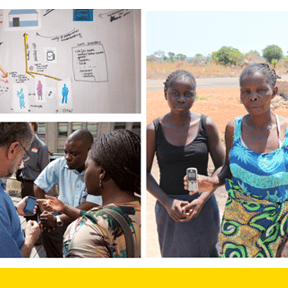- 2012
Project Mwana is a mobile service that delivers HIV lab results in real time to rural clinics. It is also a messaging platform between clinics and community health workers to ensure that results are communicated directly to mothers. Project Mwana is currently serving as a demonstration project for a new approach to collaborative design to enhance the use of real-time data within UNICEF.
Despite major advances in vaccines and treatments, many millions of children die unnecessarily each year, as much due to lack of access to information as to lack of access to medical supplies. The health minister of Zambia asked UNICEF to improve infant diagnosis and treatment in rural areas that sit far outside the reach of traditional infrastructure.
UNICEF normally takes a supply-first approach. The goal here was to flip that model and start with the end user. The team hoped to demonstrate the power of combining collaborative design methods and mobile technologies to reach the underserved and to create a model that could be applied across other programming areas.
The team faced a number of challenges in rural Zambia: few families own mobile devices, network coverage is intermittent, there are long distances between villages and clinics, and clinics have only the most antiquated record-keeping systems. These constraints forced the team to work with the materials and people at hand, focusing on volunteer community health workers (CHWs) who are the only consistent link in the chain. The solution had to be designed for and with the CHWs without adding more layers of rules to further complicate their lives.
The quality of the solution is based entirely on working rapidly and iteratively to design and deploy concepts in small increments. The first piece tested was a system for getting HIV results from a central lab back to the clinic via text messages, replacing a postal system that took up to four weeks to deliver the same information. The success of this solution created trust within the community that was essential to solving the much more difficult problem of helping CHWs understand the information, communicate it effectively to mothers, get infants into treatment and report back to the health ministry.
The design of this next layer required active participation from the CHWs. The team got immersed in their lives and routines, both in the clinic and in the community, and gave them phones to test early prototypes. Because CHWs receive very little feedback, the design team wanted a feature that let all the CHWs within a given community see how many results each worker was delivering per week. The CHWs also requested an open channel to ask questions, which allows the system to learn from them. Finally, upon reporting results each CHW gets thanked via a text message, a perfect illustration of the type of feature that would not have been created without a user-centered design process.
Credits: frog
Client: UNICEF
Contact: Jaleen Francois: [email protected]
